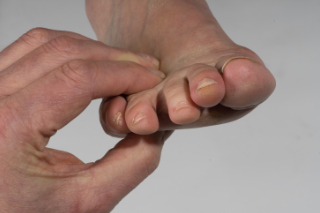
Morton's neuralgia is a nerve entrapment between two metatarsals. The entrapped nerve becomes irritated. Usually it concerns the nerve between the 3rd and 4th metatarsal, sometimes also between the 2nd and 3rd metatarsal. When the nerve is very irritated, it can swell, increasing the chance of getting stuck between the metatarsals. The problem often arises at this location because two nerve pathways come together here. Where these two nerves come together, the nerve is thicker in diameter than the other nerves that go to the toes. The nerve is also located in the subcutaneous adipose tissue, just above the fat pad of the foot, close to the artery and veins (blood vessels). Above this nerve is a thick ligament (band) that holds the metatarsals together. This ligament is very strong and forms the roof above the nerve. The ground surface presses, with every step, from below against the thickened nerve and the thick ligament exerts pressure downwards. This causes compression of the nerve in the narrow space between the metatarsals.
The cause of this condition can be manifold. Often an abnormal foot position is responsible for the onset of the symptoms, of course in combination with the load and activities that are undertaken. Various activities, such as running, tennis, football or the use of tight-fitting shoes or walking on high heels, can cause neuralgic (nerve) complaints.
The symptoms in the initial stages of the complaint are mainly characterized by acute periods of pain in the forefoot with radiating pain to the toes. The pain almost always occurs suddenly during walking/sports and has the character of cramp or a cutting pain. Taking off the shoe and massaging the foot usually provides quick relief from the complaints. Over time, the pain periods occur more quickly and last longer. The complaints no longer disappear as quickly from taking off the shoes or massage. Over time, nerve thickening (neuromas) can become so thick that it becomes impossible to wear shoes without pain and the pain becomes chronic.
In the treatment in the acute phase, it is important to relieve the excess pressure and ensure that the nerve is "free" again. This can be done by a therapeutic sole. A suitable shoe advice is also a (additional) therapy option.
